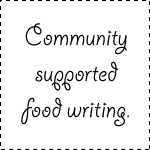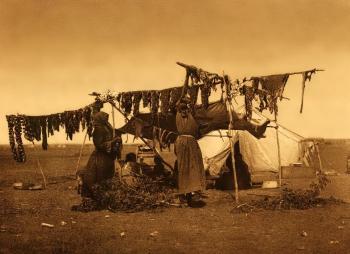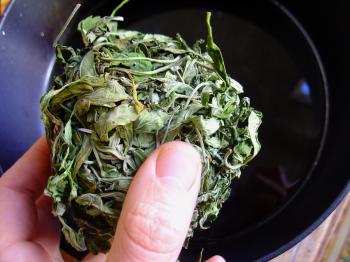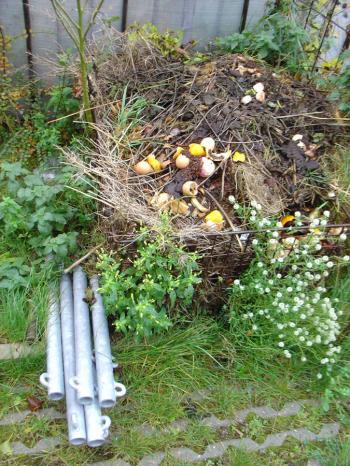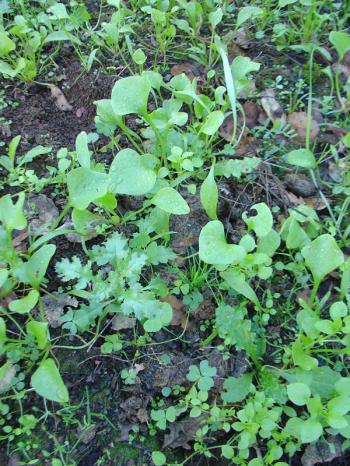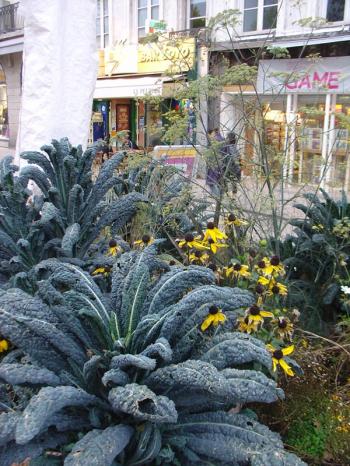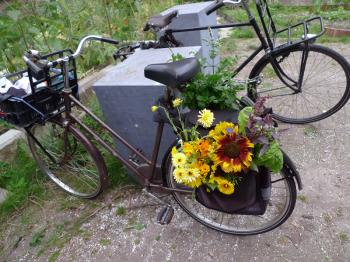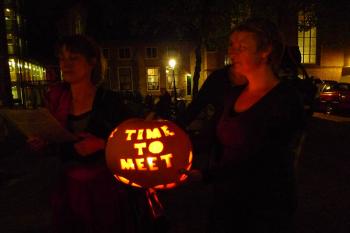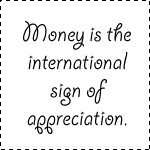Got a cutting-edge food-related project?
September 18, 2006
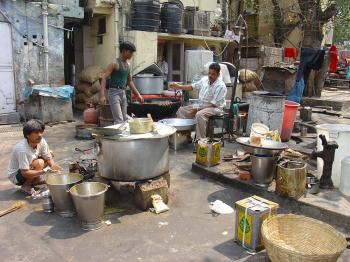
A Delhi street kitchen doing booming business
The deadline for the DOORS OF PERCEPTION 9 conference on “JUICE” (FOOD, FUEL, DESIGN) has been extended until September 30, 2006. If you think your project should be included in this event, please put your nose to the grindstone forthwith. Any questions, contact me via the comment below and I’ll get back to you within a day or two.
A] CALL FOR PROJECT CASE STUDIES
Doors of Perception 9 takes place in New Delhi 28 February to 4 March 2006. The theme is “Juice: Food, Fuel, Design”. Doors 9 begins with a two-day Project Leaders Round Table that is limited to 50 participants. This is followed by an open-to-all one day conference at India Habitat Centre, plus a Social Technologies Bazaar, on Saturday 3 March.
For the Project Leaders Round Table, we are looking for sixteen participants whose project raises interesting design issues in relation to:
• Food information systems (food miles, energy use, GMOs);
• Localisation of food systems (Community Supported Agriculture);
• Urban farming (rooftop, vertical…);
• Sustainable packaging and distribution;
• Slow food using high tech;
• New forms of community cooking (meal assembly centres);
• Agritourism;
• Street food.
Your project proposals will be reviewed by: Aditya Dev Sood, Centre for Knowledge Societies; Debra Solomon, culiblog.org; Juha Huuskonen, PixelAche; Amy Franseschini, futurefarmers; John Thackara, Doors of Perception. Send us an email in answer to these six questions:
1. Why? = the main question asked by the project
2. Who are the actors/partners?
3. Where? (the locality or situaton)
4. What are the desired outcomes/results of the project?
5. When (timeframe)?
6. How can the Project Leaders Round Table help? What problem, challenge or dilemma does the project face, that the assembled experts can help you with?
Send your project description email (Subject header: “juice project”) to: editor@doorsofperception.com
B] OPEN PROGRAMME
A one-day conference on Saturday 3 March, in the India Habitat Centre, will address the key issues to do with food, fuel and design. The results of the Round Table will be presented. And a social technologies bazaar will provide participants with a show-and-tell opportunity. Conference participants are invited to the Doors Holi Party the following day.
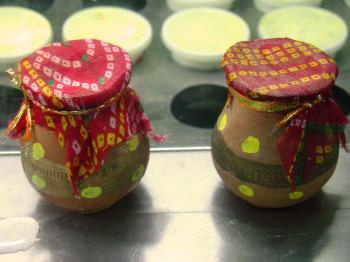
Bhang ice cream ready for Holi
C] HOW TO WIN A FREE TRIP TO DOORS 9
Doors has teamed up with the Royal Society of Arts (RSA) and Designs of the time (Dott07) to offer travel-included scholarships to Doors 9. The scholarships are for up to eight winning teams in the 2006-2007 RSA Design Directions competition. Dott 07 has set two themes – on food information systems, and sustainable tourism. All you have to do is win. Details at:
http://www.rsadesigndirections.org/dott07.html
http://www.dott07.com/go/education/dott-rsa-design-directions
D] LIMITED EDITION PACKAGE DEAL FOR DOORS 9
For those not eligible to compete in Design Directions, we can offer a limited number of all-in packages comprising flight, registration, accomodation and food for the whole Doors 9 week, for 1,000 euros. To be eligible for this package, we must receive your project proposal by Friday 29 September (which is when our cheap flights expire).
The original Doors 9 call for participation is here.
debra at 15:23 | Comments (0) | post to del.icio.us
Food causes gas, and by gas, I mean greenhouse gas
September 7, 2006
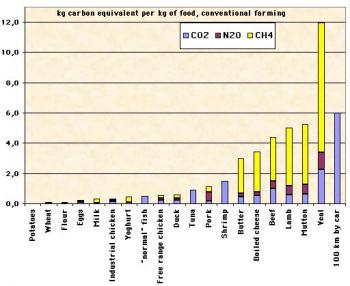
Greenhouse gas emissions linked to the production of a kg (roughly 2 pounds) of food. Meat refers to the “carcass equivalent”, with bones but without processing, packaging, or transportation. Source IFEN 2004 for France
Jean-Marc Jancovici, whose website on climate change with readable, chartful and well-documented articles, estimates that roughly one-third of carbon emissions are a result of just simply getting the grits on the table. Although Jancovici has thoughtfully translated his French texts into English, one has to read them with a French accent to get through the Franglais. But chapeau to the man who does his math and collates all this research into easy to understand facts. Check it, below!
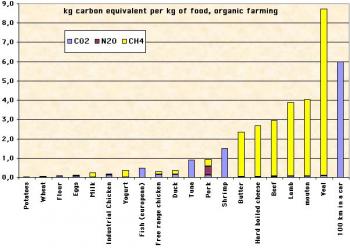
Now check out what happens when one farms organically. Source IFEN 2004 for France
- Jean-marc Jancovici: how much greenhouse gas is on our plate?
- Via John from Doors of Perception via Jean-Marc Jancovici of Manicore
The U.S. food system consumes ten times more energy than it produces in food energy. This disparity is made possible by nonrenewable fossil fuel stocks.
127 calories of energy are used to grow and export one calorie of lettuce from the US to the UK.
In ‘developed’ countries, CO2 emissions attributed to producing, processing, packaging and distributing the food is about 8 tonnes a year for a family of four.
Agriculture and food now account for nearly 30 percent of goods transported on Europe’s roads.
95 percent of the fruit and half the vegetables eaten in the UK are imported.
There are 52 transport and process stages in one bottle of ketchup.
In France, 20 percent of money spent by citizens on food is devoted to raw products such as fruit, vegetables, or fresh meat of fish. The rest is used to buy processed food : pasta, canned food, frozen food, biscuits and sweets, drinks, etc.
These processing industries consume energy and therefore emit greenhouse gases.
Most processed foods are packaged. Manufacturing the packaging (steel, aluminium, plastics) accounts for 70- 80 percent of the overall emissions of the food industry.
Processed food is generally bought in supermarkets which consume electricity to keep foods frozen - especially in open display units.
Most supermarkets sell industrially-grown chickens. The lifecycle of such a bird entails:
- Emissions linked to the heating of the hen house;
- Fossil fuels used to manufacture the fertilizers used to grow the grain eaten by the chicken;
- Fossil fuels burnt by the tractor used to grow the grain eaten by the chicken;
- Nitrous oxide (N2O) emissions that occur when the fertilizers are spread on the field;
- Fossil fuels required to manufacture chicken food (industrial chickens rarely eat “raw” cereals, but rather processed foods) from the cereals;
- Emissions linked to the manufacturing of tractors, to the drying of grain, and to the refinery of the diesel oil used by the tractor….Eating meat requires intensive agriculture because it is necessary to grow a lot of plants to feed the animals.
When decaying, nitrogenous fertilizers cause N2O emissions, 300 times more powerful than CO2.
Ruminants emit methane, which is 23 times more powerful than CO2, because of the fermentation of the plants they eat in their digestive sysem.
Producing an unprocessed kilogramme (2.2 pounds) of beef (with bones) leads to the emission of three to four kilogrammes (nearly nine pounds) of carbon equivalent.
Between 65 and 70 percent of the available agricultural land in France is devoted to feeding animals.
Fruits and vegetables (except for potatoes and vineyards) acount for two percent of the total.The amount of meat consumed by an inhabitant of the Earth has increased by 60 percent over the last 40 years while the world population has doubled. Meat production has been multiplied by 3.2
Every cow in the European Union is subsidised by $2.50 a day.
One in five people in the world lives on less than $1 a day.The US insists that 50 percent of its food aid is processed or bagged.
Poor diet and physical inactivity account for 35 percent (and rising) of avoidable causes of deaths in the US.
People in industrialised countries eat between six and seven kilogrammes (about 15 pounds) of food additives every year.
Supermarkets are heated in the winter and cooled in the summer. Heating and cooling stores represents, in France, between 1,5 and 2 million tonnes carbon equivalent carbon.
Supermarkets are usually located in suburbs so we use cars to get there. In the UK, 25 percent of car journeys are to get food.
In the home, our use of processed foods causes us to use more energy in fridges and freezers, stoves ovens, microwaves.
In France, the electricity consumption linked to eating (fridges, freezers, dish-washers, stoves and ovens, not to mention small appliances) represents 22 percent of all energy consumed at home,
25 percent of domestic waste is composed of food waste which, when landfilled, leads to methane emissions.
debra at 6:53 | Comments (0) | post to del.icio.us
The issue of financial gain with regard to an allotment
September 5, 2006
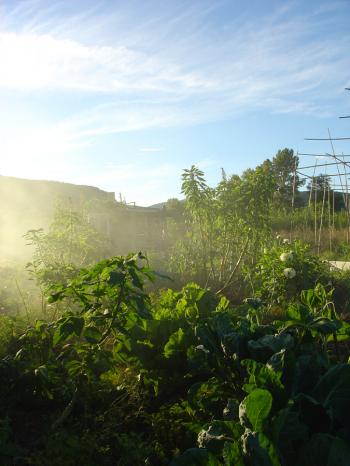
My neighbour Sidi ElGouche is smokin’ again.
Yesterday my dear colleague (from the Dott07 CityFarming project) posed the very good question of how much one could earn from one’s kitchen garden. Apparently he had read two disparate studies and the numbers varied ten-fold as to what a garden allotment yields in terms of produce. As per usual, my answer was blunt and wordy:
From my UNSCIENTIFIC, culiblogish research into the matter (in the form of having an allotment for 2 years), I can say that in pure economic terms, these will be the most expensive tomatoes and lettuces I will ever eat. I can buy 3 head of lettuce at the organic farmer’s market for 1 euro.
Why is my allotment produce so expensive? Because time is money, honey. In order to have an allotment, I have to reorder my life, and in a rather extreme way. My kitchen garden is one big black hole of very expensive time.
But the amount of pleasure I get from my garden, even when I am away from it, is UNSPEAKABLY LARGE. What does that mean financially for my physical and mental health, aside from free access to the potentially healthy veg? What about the relationships that I have to build up to be part of an allotment group? What are those worth? These relationships nourish me and improve my quality of life. In my unique situation, they offer me access to a diverse culture. My garden gives me a place in the community and some people know me and like me simply because I have a garden. Suddenly I’m a nice person.
To get to my garden I ride my bike down a country lane with astounding views and watermills and clear views of all the town’s farms. My heart is racing because of the sheer physical beauty. I am smiling. I see what the farmers are growing. I see the geese that Monsieur Caizergue just bought to raise for an Xmas slaughter. I have something to talk about with everyone along the road. Hell, the garden was the reason that I was invited to a dazzling Berber wedding last April!
And the garden keeps me a bit physically fit.
And the garden yields some vegetables, soft fruit and some flowers.
Big whoop.
If someone were to say to me, ‘Here’s ÂŁ3.000,- (or ÂŁ300,- for that matter) of high-quality free veg, flowers, herbs and soft fruit spread out over the course of a year,’ I’d accept, but I don’t see that as being the only benefit of having a garden. To cite financial gain as a potential benefit specifically or separately from a multitude of other factors is to not truly address what a garden allotment really is. Or what a garden allotment can do to you.
If you want:
- warm relationships with a new set of inspiring friends
- a positive sense of who makes up your community
- more conviviality in your life
- knowledge about the flora and fauna in your environment
- a grasp of your area’s weather
- a role in increasing bio-diversity in your region
- a taste of yer own dang terroir
- expertise in the art of preparing traditional foods from your turf
- a connection with the history of your small corner of the world in cultural as well as geologic terms
- a sense of accomplishment for growing your own food
- a role in decreasing pollution and your area’s reliance on petrol products
- a regular supply of endorphin
- ÂŁ 300,- (or ÂŁ 3.000,-) worth of fresh veg, fruit and flowers in season
- the smug feeling of self-righteousness
- an excellent ass
Get an allotment.
debra at 15:41 | Comments (0) | post to del.icio.us
